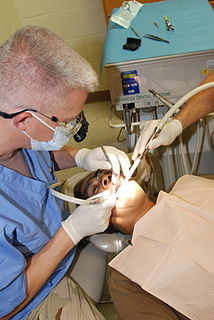
Dentistry, also known as dental medicine and oral medicine, is a branch of medicine that consists of the study, diagnosis, prevention, management, and treatment of diseases, disorders, and conditions of the oral cavity, commonly in the dentition as well as the oral mucosa, and of adjacent and related structures and tissues, particularly in associated maxillofacial area. The field of dentistry or dental medicine includes teeth as well as other aspects of the craniofacial complex including the temporomandibular joint and other supporting, muscular, lymphatic, nervous, vascular, and anatomical structures. The practitioner is called a dentist.
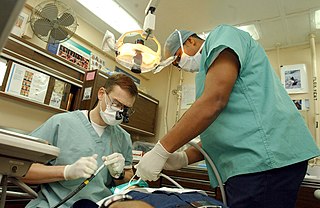
A dentist, also known as a dental surgeon, is a health care professional who specializes in dentistry. The dentist's supporting team aids in providing oral health services. The dental team includes dental assistants, dental hygienists, dental technicians, and sometimes dental therapists.

The Medical University of South Carolina (MUSC) is a public medical school in South Carolina. It opened in 1824 in Charleston, SC as a small private college aimed at training physicians and has since established hospitals and medical facilities across the state. It is one of the oldest continually operating schools of medicine in the United States and the oldest in the Deep South. The school's main building was designed by Charleston architect Albert W. Todd.
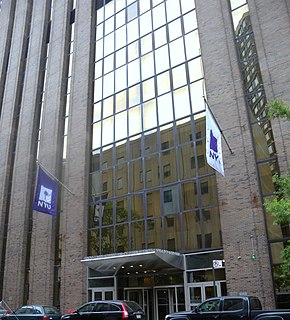
The New York University College of Dentistry is the dentistry school of New York University. As the 3rd oldest dentistry school in the United States, it offers both graduate programs and clinical training in oral healthcare.

A dental hygienist or oral hygienist is a licensed dental professional, registered with a dental association or regulatory body within their country of practice. Prior to completing clinical and written board examinations, registered dental hygienists must have either an Associate's or bachelor's degree in Dental Hygiene from an accredited college or university. Once registered, hygienists are primary healthcare professionals who work independently of or alongside dentists and other dental professionals to provide full oral health care. They have the training and education that focus on and specialize in the prevention and treatment of many oral diseases.
There are a number of professional degrees in dentistry offered by dental schools in various countries around the world.

The UCLA School of Dentistry is the dental school of the University of California, Los Angeles (UCLA) located in the Center for Health Sciences building in the Westwood neighborhood of Los Angeles, California, United States. The school has several educational and training programs, conducts oral and dental health research, and offers affordable dental care at three locations: Westwood, Venice, and Inglewood. The school also participates in several outreach endeavors, including numerous health fairs during the year, STEM pipeline programs and provides dental care for underserved populations in the region. The School of Dentistry is considered among the nation's best research-intensive dental schools.

The Henry M. Goldman School of Dental Medicine is the dental school at Boston University. Its curriculum is based on the Applied Professional Experience (APEX) Program, which gives students practical experience at a dental practice as part of clinical training. The School has about 800 students in predoctoral and postdoctoral programs.

The Royal College of Surgeons of Edinburgh (RCSEd) is a professional organisation of surgeons. The College has seven active faculties, covering a broad spectrum of surgical, dental, and other medical practices. Its main campus is located on Nicolson Street, Edinburgh, within the Surgeons' Hall, designed by William Henry Playfair, and adjoining buildings. The main campus includes a skills laboratory, the Surgeons' Hall Museums, a medical and surgical library, and a hotel. A second office was opened in Birmingham (UK) in 2014 and an international office opened in Kuala Lumpur, Malaysia, in 2018.
The University of Pittsburgh School of Dental Medicine is the dental school of the University of Pittsburgh (Pitt). It is located in Pittsburgh, Pennsylvania, United States. It is one of Pitt's six schools of the health sciences and one of several dental schools in Pennsylvania. It is closely affiliated with the University of Pittsburgh Medical Center. The School of Dental Medicine accepted 3.6% of applicants for the class of 2016, a record low for the school's entire history.

Dental assistants are members of the dental team. They support a dental operator in providing more efficient dental treatment. Dental assistants are distinguished from other groups of dental auxiliaries by differing training, roles and patient scopes.

Dentistry throughout the world is practiced differently, and training in dentistry varies as well.
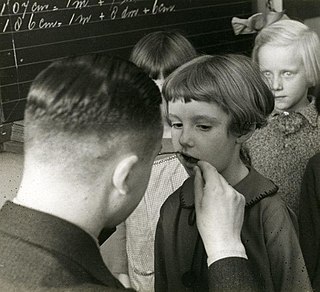
Pediatric dentistry is the branch of dentistry dealing with children from birth through adolescence. The specialty of pediatric dentistry is recognized by the American Dental Association, Royal College of Dentists of Canada, and Royal Australasian College of Dental Surgeons.

The Creighton University School of Dentistry is the dental school of Creighton University. It is located in the city of Omaha, Nebraska. It was one of the first dental schools in the United States, having been established in 1905.
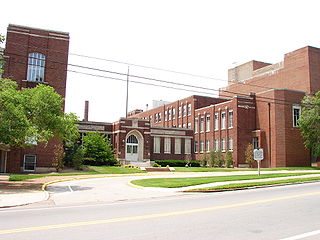
The School of Dentistry is a dental school within Meharry Medical College located in the United States city of Nashville. The school is one of the dental schools in the state of Tennessee.

The UNC Claude A. Adams Jr. and Grace Phillips Adams School of Dentistry is the school of dentistry of the University of North Carolina. It is located in Chapel Hill, North Carolina, United States. It is currently ranked second among all dental schools in the U.S. and is consistently ranked among the best in the world according to two independent rankings. Founded in 1950 as the UNC School of Dentistry, it was the only dental school in North Carolina until 2011, when East Carolina University School of Dental Medicine became the second. In 2019, the school received its largest single donation of $27.68 million dollars, resulting in a name change to honor Dr. Claude A. Adams Jr. and Grace Phillips Adams. Dr. Adams was a North Carolina dentist that practiced in Durham until his death in 2018.
The practice of 'dentistry in the United States is overseen by several agencies, including the American Dental Association, the Commission on Dental Accreditation, and the regional boards. Ultimate licensure is the responsibility of individual states. There are roughly 190,000 practicing dentists in the United States.
Evidence-based dentistry (EBD) is the dental part of the more general movement toward evidence-based medicine and other evidence-based practices. The pervasive access to information on the internet includes different aspects of dentistry for both the dentists and patients. This has created a need to ensure that evidence referenced to are valid, reliable and of good quality.

In the past, Kosovo’s capabilities to develop a modern health care system were limited. Low GDP during 1990 worsened the situation even more. However, the establishment of the Faculty of Medicine in the University of Pristina marked a significant development in health care. This was also followed by launching different health clinics which enabled better conditions for professional development.

The Georgetown University School of Dentistry was the dental school of Georgetown University, located in Washington, D.C. The school was established in 1901 as a department of the School of Medicine and became a standalone school within the university in 1956. In 1987, the school stopped accepting new students and graduated its last class in 1990.


















